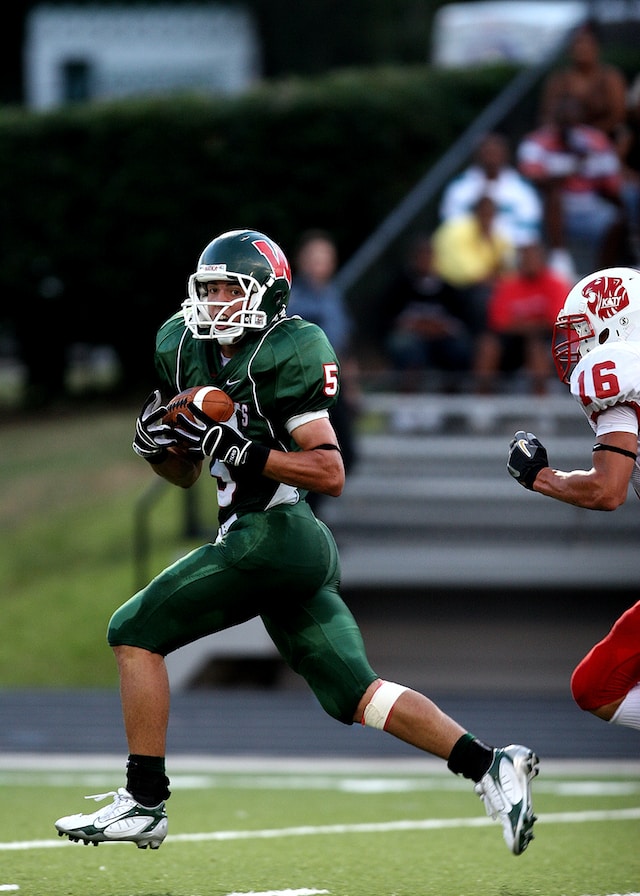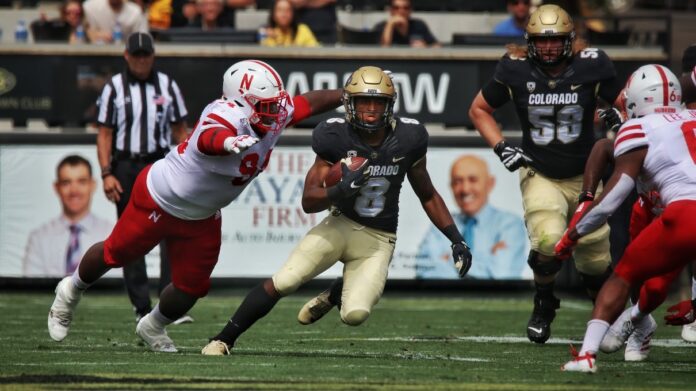Have you ever watched a football game and wondered about those football arm tape on players hand? We’re diving deep into this intriguing aspect of the sport to uncover the reasons behind this common practice. From practical purposes to psychological advantages, arm taping in football is more than just a fashion statement. Let’s explore the world of gridiron arm accessories and discover why players swear by this simple yet effective technique.
The Evolution of Arm Taping in Football
A Brief History of Athletic Taping
Before we tackle the specifics of arm taping, let’s take a quick journey through time. Athletic taping has been around for decades, evolving from basic injury prevention to a multi-faceted tool in sports performance.
From Medical Necessity to Performance Enhancer
Initially, taping was primarily used for injury prevention and support. However, as sports science advanced, so did the applications of taping. Today, it’s not uncommon to see athletes in various sports, including football, using tape for reasons beyond just injury prevention.
When Did football Arm Tape Become Popular in Football?
The trend of arm taping in football gained significant momentum in the late 1990s and early 2000s. As high-profile players began sporting taped arms, the practice quickly spread throughout the ranks, from professional leagues to college and high school levels.
The Primary Reasons for Arm Taping in Football
1. Injury Prevention and Support
One of the most straightforward reasons for arm taping is to prevent injuries and provide support to muscles and joints. Football is a high-impact sport, and players are constantly at risk of strains, sprains, and other injuries.
How Tape Supports Muscles and Joints
Properly applied tape can:
- Limit excessive movement of joints
- Provide compression to reduce swelling
- Support weakened areas prone to injury
2. Enhanced Grip and Ball Control
In a sport where catching and holding onto the ball is crucial, anything that can improve grip is valuable. Arm tape, especially when applied to the forearms, can provide an extra tacky surface for better ball control.
The Science Behind Improved Grip
The slightly rough texture of athletic tape can increase friction between the player’s arm and the ball, potentially making the difference between a completed pass and an incomplete one.
3. Protection Against Abrasions and Turf Burn
Football players are no strangers to sliding across the field, whether it’s grass or artificial turf. Arm tape acts as a protective barrier against painful abrasions and turf burn.
Why Turf Burn is a Concern
Artificial turf, while popular for its durability and low maintenance, can be particularly abrasive. The tape provides a sacrificial layer that takes the brunt of the friction, sparing the player’s skin.
4. Psychological Edge and Intimidation Factor
Never underestimate the power of psychology in sports. For some players, arm tape is part of their game face, giving them a mental boost and potentially intimidating opponents.
The Warrior Mentality
The act of taping up can be a ritual that helps players get into the right mindset for the game. It’s like putting on armor before heading into battle.
The Different Types of Arm Tape Used in Football
Athletic Tape vs. Kinesiology Tape
While traditional white athletic tape is the most common sight on the football field, some players opt for colorful kinesiology tape. Each type has its own set of benefits and applications.
Properties of Athletic Tape
- Rigid and supportive
- Provides compression
- Typically white in color
Properties of Kinesiology Tape
- Elastic and flexible
- Aims to support muscles without restricting movement
- Available in various colors
Pre-wrap and Its Importance
Before applying tape directly to the skin, many players use a thin foam layer called pre-wrap. This serves several purposes:
- Protects the skin from tape adhesive
- Absorbs sweat
- Makes tape removal less painful
Techniques and Patterns in Arm Taping
Common Taping Patterns
Players and trainers have developed various taping patterns over the years, each designed for specific purposes or preferences.
The Spiral Wrap
This technique involves wrapping the tape in a spiral pattern up the arm. It’s popular for its simplicity and effectiveness in providing overall support.
The Checkerboard
Some players prefer a crisscross pattern that resembles a checkerboard. This can offer more targeted support to specific areas of the arm.
How to Properly Apply Arm Tape
Proper application is key to reaping the full benefits of arm taping. Here’s a general guide:
- Clean and dry the skin thoroughly
- Apply pre-wrap if desired
- Start the tape at the wrist, anchoring it securely
- Wrap up the arm, overlapping each layer by about 50%
- Avoid wrapping too tightly to prevent circulation issues
- Finish with a secure end piece to prevent unraveling
The Role of Arm Tape in Different Football Positions
Wide Receivers and Tight Ends
These players often tape their arms to improve grip and protect against defensive backs’ attempts to strip the ball.
Defensive Backs and Linebackers
For defensive players, arm tape can provide support during tackles and help prevent injuries when grappling with offensive players.
Quarterbacks and Their Unique Taping Needs
While less common, some quarterbacks use arm tape to support their throwing arm or improve grip on the ball during wet conditions.
Beyond Function: The Fashion of Arm Taping
Customization and Personal Branding
Some players use arm tape as a canvas for personal expression, writing messages or drawing designs that reflect their personality or beliefs.
Team Colors and Unity
In some cases, colored tape is used to match team colors, creating a unified look across the squad.
The Controversy and Regulations Surrounding Arm Tape
NFL Rules on Arm Tape
The NFL has specific regulations regarding the use of tape and other accessories. These rules aim to maintain fairness and prevent any unfair advantages.
Debates Over Performance Enhancement
There have been discussions about whether certain taping techniques provide an unfair advantage, particularly regarding grip enhancement.
The Future of Arm Taping in Football
Technological Advancements in Sports Tape
As materials science progresses, we may see new types of tape that offer even more benefits to players.
Potential Alternatives to Traditional Taping
Some companies are developing compression sleeves and other alternatives that may eventually replace or supplement traditional taping methods.
Expert Opinions: What Trainers and Players Say

Insights from Professional Trainers
Many trainers swear by arm taping, citing its preventive benefits and psychological impact on players.
Player Testimonials
Numerous players have spoken about how arm taping has helped their game, from preventing injuries to boosting confidence.
DIY Arm Taping: Tips for Amateur Players
Essential Supplies for Arm Taping
If you’re considering trying arm taping yourself, here’s what you’ll need:
- Athletic tape or kinesiology tape
- Pre-wrap (optional but recommended)
- Scissors
- Skin cleaner
Step-by-Step Guide for Beginners
- Clean your arm thoroughly
- Apply pre-wrap if using
- Start with an anchor strip around your wrist
- Choose your pattern (spiral or checkerboard)
- Wrap firmly but not too tight
- Secure the end with an extra piece of tape
Common Mistakes to Avoid
- Wrapping too tightly and restricting circulation
- Not cleaning the skin properly before application
- Using old or low-quality tape that doesn’t adhere well
The Psychological Impact of Arm Taping
Building Confidence Through Ritual
For many players, the act of taping their arms is a pre-game ritual that helps them mentally prepare for the challenges ahead.
The Placebo Effect in Sports
Even if the physical benefits are minimal, the belief that arm tape improves performance can lead to actual performance enhancements through the placebo effect.
Conclusion: More Than Just Tape
As we’ve explored, the practice of arm taping in football is a multifaceted phenomenon that goes beyond simple injury prevention. It’s a blend of practical functionality, psychological preparation, and personal expression. Whether it’s providing crucial support, enhancing grip, or giving players that extra boost of confidence, arm tape has become an integral part of the modern football player’s kit.
The next time you watch a game, take a moment to notice the various taping styles and patterns on display. Each strip of tape tells a story of preparation, strategy, and the individual player’s approach to the game. In the end, while it may seem like a small detail, arm taping is yet another example of how players seek every possible edge in the highly competitive world of football.
FAQs About Football Players Wearing Arm Tape
Does arm tape improve performance in football?
While scientific evidence is mixed, many players report improved grip and confidence when using arm tape. The psychological benefits alone can contribute to better performance on the field.
Is arm taping allowed at all levels of football?
Most leagues allow arm taping, but there may be specific regulations regarding the type of tape used and how it’s applied. Always check with your league’s rules before using tape in a game.
Can arm taping prevent all types of arm injuries in football?
While arm taping can help prevent certain injuries and provide support, it’s not a guarantee against all types of arm injuries. Proper training, conditioning, and technique are still crucial for injury prevention.
How often should arm tape be replaced during a game?
This depends on the intensity of play and environmental conditions. Some players re-tape at halftime, while others may need to adjust their tape more frequently if it becomes loose or wet.
Are there any risks associated with arm taping in football?
If applied incorrectly, arm tape can potentially restrict blood flow or cause skin irritation. It’s important to learn proper taping techniques and to remove the tape promptly after games and practices.


